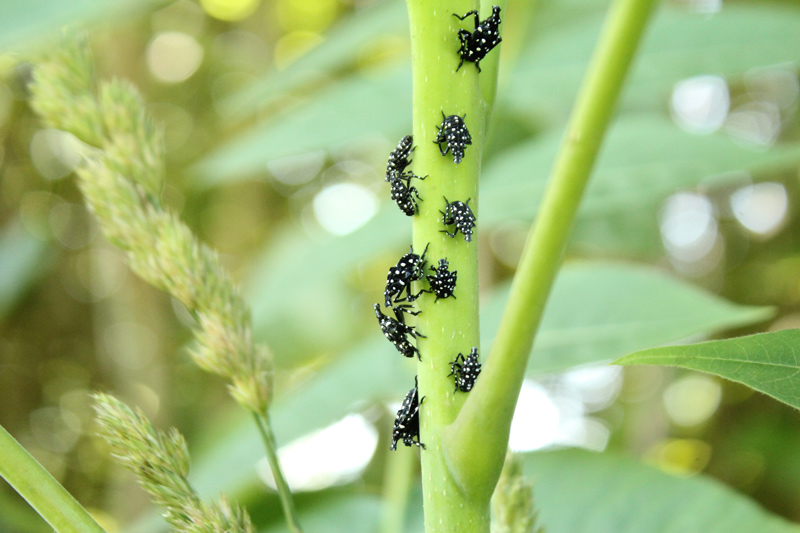


Unwelcome insect hitchhikers
Photos by Katie Young and Isaiah Bell March 16, 2023
Researchers find human transportation largely responsible for spread of invasive spotted lanternfly
Spring brings warmer weather, blooming flowers and the unfortunate re-emergence of the spotted lanternfly, a prolific invasive insect reviled for the havoc it wreaks on forests and cropland. Today, you may see egg masses — be sure to remove them if you do — and soon the nymphs will hatch across the mid-Atlantic. Arriving from Asia, spotted lanternflies were first detected in Pennsylvania in 2014 and since have spread to more than 100 counties across 14 states.
How are these miniature menaces able to relocate far and wide? In a recent study published in the journal Scientific Reports, researchers from the University of Delaware, U.S. Forest Service, and Pennsylvania Department of Conservation and Natural Resources found that the spread of the spotted lanternfly population is largely due to human-mediated dispersal via transportation. In other words, these expert hitchhikers are catching rides on our cars, trucks and trains.
“Spotted lanternflies can spread quickly into suitable habitat and have the potential to cause significant economic damage to crops and hardwood trees,” said Tara Trammell, John Bartram Associate Professor of Urban Forestry in UD’s College of Agriculture and Natural Resources. “Studying potential dispersal mechanisms, such as human transportation, can help us develop management approaches to reduce further spread.”
The research team simulated spotted lanternfly spread dynamics using agent-based models that incorporated information on habitat suitability, life history, movement and natural dispersal behaviors.
“We were quite surprised by the overwhelming effect of human-mediated dispersal in accurately predicting spread dynamics. This supported the current observational data and some of the long-distance jumps we know the spotted lanternfly has made,” said Zach Ladin, supervisory wildlife biologist with the U.S. Fish and Wildlife Service and lead author on the study. Ladin is a UD alumnus and former postdoctoral researcher in Trammell’s urban ecology lab.

Upon hatching, spotted lanternflies develop through four juvenile life stages and largely mobilize by crawling and jumping before they mature into winged adults. From June through September, both juveniles and adults are present, making this a critical time of year when human-mediated dispersal is most likely. This is also when mating and egg laying occur.
“The primary mode of human-mediated dispersal is still to be determined. For example, it could be egg masses laid on vehicles or gravid females hitchhiking on vehicles,” said Ladin. “That would be a great follow-up experiment. Future studies could mark and track egg masses on train cars and measure egg mass survival, or mark and track hitchhiking nymphs and adults on tractor trailers.”
Demonstrating the role of transportation and human behavior in dispersing the spotted lanternfly is a critical first step, but slowing the spread will require additional public education and outreach. If we do nothing to modify human behavior, the spotted lanternfly population will likely spread quickly to suitable habitat across the continent, with unpredictable ecological and economic impacts.
Ladin said that a few modifications could make a world of difference.
“The number one suggestion is to follow state recommended guidelines for monitoring vehicles. We suggest people in areas with established spotted lanternfly populations be vigilant when traveling across state lines and follow suggested protocols for monitoring their vehicles when going on long-distance trips,” he said. “Additionally, management and removal of the suite of host trees that spotted lanternflies use to reproduce will help diminish the number of individuals on the landscape, which can lower the likelihood of spotted lanternfly hitchhikers and the establishment in previously unoccupied habitat.”
Managing spotted lanternfly in Delaware
Brian Kunkel, ornamentals integrated pest management specialist with UD’s Cooperative Extension, notes that the management opportunities available to Delaware homeowners vary by season.
In the late spring, summer and early fall, insecticides and traps may provide some relief from spotted lanternfly infestations. In winter and early spring, scraping egg masses could help prevent the next generation of lantern flies from hatching.

Spotted lanternfly egg cases look like a smudge of brownish-gray dirt, several inches in length and an inch or two wide. Just underneath the top layer sit several rows of eggs. Removing a single egg case destroys 30-50 spotted lanternfly eggs, helping to reduce the population. Kunkel suggests using a scraping object like the edge of a credit card or ice scraper to move the entire egg mass into a container with rubbing alcohol to ensure that no eggs survive removal.
Upon detecting and confirming the presence of spotted lanternflies in Sussex County, the Delaware Department of Agriculture expanded the spotted lanternfly quarantine to include the entire state, effective July 12, 2022. You can help officials track the movement of the lanternfly population by reporting any sightings.
Year-round vigilance is critical. Visit Cooperative Extension’s spotted lanternfly resources to learn more about identifying and managing this unwelcome invasive insect.
Contact Us
Have a UDaily story idea?
Contact us at ocm@udel.edu
Members of the press
Contact us at 302-831-NEWS or visit the Media Relations website

